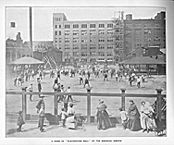| Entries |
| P |
|
Playground Movement
|

|
In 1898, the Municipal Science Club began studying Chicago's need for additional “breathing spaces,” and in the following year the mayor created the Special Park Commission (SPC) to create municipal playgrounds in the city's most densely populated neighborhoods. Working cooperatively with the Board of Education and the three park commissions, the SPC urged elementary schools to construct adjacent playgrounds and the park commissions to create new parks and playgrounds.
The South Park Commission became the most involved in this effort to create municipal recreation spaces and in 1902 opened the experimental McKinley Park with ball fields, a swimming lake, and open-air gymnasium. In 1903 the South Park Commission embarked on an ambitious system of neighborhood parks that became a model for other American cities. The Olmsted Brothers landscape designers and D. H. Burnham & Co. architects were hired to design parks with running tracks, wading pools, playground apparatus, sand courts, and fieldhouses in beautiful landscape settings. Opened to the public in 1905, the first 10 parks drew over five million visitors in one year.
The Encyclopedia of Chicago © 2004 The Newberry Library. All Rights Reserved. Portions are copyrighted by other institutions and individuals. Additional information on copyright and permissions.